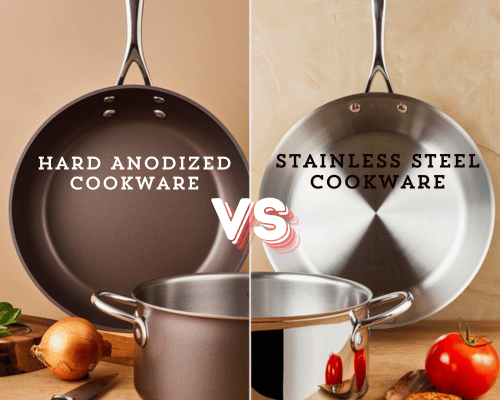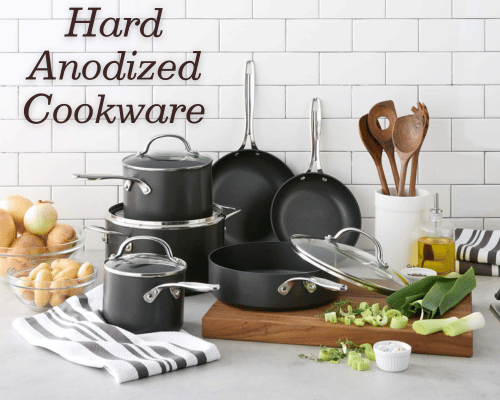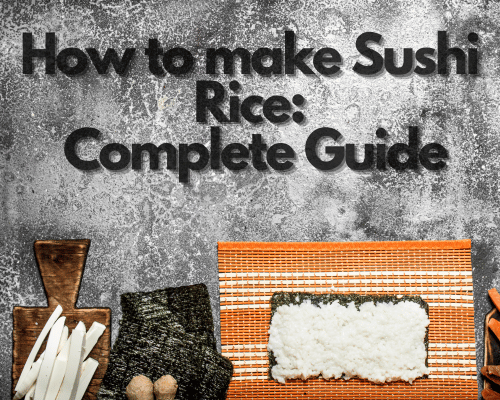Hard Anodized vs Stainless Steel

Both hard anodized and stainless steel cookware are very popular all over the world. But are they both suitable for cooking? Stainless steel is made primarily from iron and carbon in a two-step process, whereas hard anodizing produces a very thin, non-metallic conversion coating. Hard anodizing and stainless steel are still not completely explained by that. We will discover these cookware characteristics in this article and examine the advantages and disadvantages of both hard anodized and stainless steel cookware.
Hard Anodized Cookware

We must explore the hard anodization process to truly understand the allure of hard anodized cookware. Aluminum cookware’s surface is changed by the hard anodization process, which also increases its durability and resilience. When aluminum cookware is submerged in an acid bath and exposed to electricity, the aluminum oxidizes and forms a hardened layer on the surface. As a result, the cookware surface becomes remarkably scratch-resistant and much harder (almost twice as hard as regular stainless steel).
Hard anodized cookware is non-reactive, which means it won’t interact with alkaline or acidic foods. It ensures precise cooking control, prevents specific hot spots, and evenly distributes heat across the cooking surface. One of the most celebrated advantages of hard anodized cookware is its resistance to scratches and abrasions. Food residue is less likely to adhere due to its non-stick qualities, and it is also incredibly simple to maintain. Let’s recognize some exceptional hard anodized cookware brands.
Calphalon: Right now, Calphalon is one of the best cookware producers in the world. They produce cookware, bakeware, cutlery, and appliances for professional cooks and home chefs. Their “Calphalon Premier” and “Calphalon Contemporary” collections are highly recommended.
T-fal: T-fal offers outstanding non-stick properties at a reasonable cost Cooking enthusiasts should consider their “Ultimate Hard Anodized Cookware” collection.
Cuisinart: Cuisinart is a classic manufacturer of hard anodized cookware. They are also known for their sturdy construction and versatility in the kitchen.
Pros of Hard Anodized Cookware
Hard anodized cookware is durable because of the hardening process. Try to remember how many times you’ve repaired your cookware because of warped or scratched cookware. Hard anodized cookware is specialized for its scratch resistance. You can stack or nest them without worrying about damage. In fact, some options, like “Calphalon Premier”, are actually designed for stacking. Because of the impressive heat distribution it guarantees, your food will cook consistently.
The non-reactive feature of hard anodized cookware prevents a metallic taste and preserves the authentic flavors of your dish. Additionally, because of its versatility, you can cook a variety of foods, including delicate ingredients like fish or eggs. The fact that hard anodized cookware requires little maintenance is another major benefit. Unlike other types of cookware, like cast iron, it does not require seasoning, so you can just clean it.
Cons of Hard Anodized Cookware
Hard anodized cookware usually comes in limited colors, such as dark or charcoal gray. Additionally, it is not recommended for high-heat searing because the non-stick coating may be damaged and lose some of its effectiveness at very high temperatures. Although it is initially non-stick, regular use over time may cause this quality to diminish. The loss of non-stick quality could be stopped with proper upkeep and more oiling. It is advised to buy cookware marked “Heavy Gauge” for a more even heating process because the quality of hard anodized cookware can vary depending on the manufacturer.
Stainless Steel Cookware

Stainless steel is also known as inox or corrosion-resistant steel. It contains at least 10.5% chromium and nickel; it may also include other elements like carbon. The main benefit of stainless steel cookware is its exceptional durability and remarkable resistance to rust and corrosion. It can tolerate high-heat cooking, repeated use, and even an accidental drop. This is why stainless steel cookware is a long-lasting investment in your kitchen.
Stainless steel cookware is also non-reactive, features a polished surface, and looks stunning in any culinary setting. For people who admire a spotless kitchen, stainless steel cookware is a classic option. It is excellent for prolonged use, and you can also experiment with some high-temperature, adaptable cooking techniques like searing, braising, and roasting. Let’s explore some famous stainless steel cookware brands.
All-Clad: All-Clad has been producing high-quality stainless steel cookware since 1971. Their “All-Clad D3” and “All-Clad D5” collections are very successful for their even heating and precision.
Tramontina: Tramontina offers quality stainless steel cookware at an affordable price. Their “Tri-Ply Clad” cookware features exceptional heat distribution.
Cuisinart: Cuisinart produces both hard-anodized and stainless steel cookware. If you are looking for high-quality cookware, “Cuisinart MultiClad Pro” is a common choice.
Pros of Stainless Steel Cookware
Compared to other cooking materials, stainless steel has a very long lifespan. It is a long-lasting investment because you can use it for many years without compromising its quality. In addition, it can handle high temperatures with ease, making it suitable for various cooking methods and oven use. In addition to being versatile for a variety of cooking methods,
stainless steel cookware’s greatest strength is its ability to resist rust. They are an excellent choice for locations where hygiene is important because they contain hygienic materials. Contaminants like dirt, grime, or bacteria have a difficult time adhering to the exterior’s smooth, non-porous surface; even if they do, they are very easy to remove. Particularly for its aesthetically pleasing appearance, stainless steel cookware is a favorite of many food enthusiasts.
Cons of Stainless Steel Cookware
Stainless steel is an excellent option for durable, non-toxic cookware. But there are some options that they do not have, like a non-stick surface. You will probably need to use additional oils to prevent certain foods from sticking, like delicate fish or eggs. Furthermore, stainless steel cookware needs to be maintained properly.
For people who are nickel-sensitive, stainless steel is not suitable at all. Plus, if you cook acidic food in stainless steel cookware for a long time, it may leach heavy metals into the food. According to a study by the “National Library of Medicine,” nickel and chromium concentrations in tomato sauce can increase up to 26 and 7-fold, respectively, after about six hours of cooking. However, the result of this experiment depends on the grade of stainless steel.
Being classified as the 200, 300, or 400 series, on the other hand, is even more confusing. The 200 series contains manganese instead of nickel and is comparatively less expensive. The 300 series produces some excellent quality grades, such as 304, 309, or 316. These higher-quality grades of stainless steel are much more resistant to corrosion and rust. The 400 series contains almost zero nickel and is the cheapest and lowest-grade stainless steel of all.
When to Use Each
Hard anodized cookware is truly remarkable for some specific cooking techniques, such as omelets and scrambled eggs, pancakes, crepes, fish fillets, or stir-fries. It is exceptional for low-fat cooking or dealing with delicate ingredients! Usually, hard anodized cookware surfaces are non-stick, which makes them ideal for dishes where limited or no oils are required. If the cookware’s surface is not non-stick, sticking will still occur when cooking delicate ingredients like fish fillets or pancakes. Hard anodized cookware also ensures superior heat distribution, which makes it ideal for recipes like risottos or sauces that require precise temperature control.
Stainless steel cookware, on the other hand, is perfect for high-temperature cooking. It produces a perfect crust when you need to achieve a deep sear on steaks or pork chops. Some dishes, such as oven-broiled seafood or roast chicken, require both stovetop searing and oven finishing. For those dishes, stainless steel cookware is a great option because it can easily go from the stovetop to the oven.
Some Pro Tips
Whether you are using hard anodized or stainless steel cookware, preheating the cookware before adding ingredients helps create an even cooking surface. While high temperatures are not a problem for stainless steel cookware, try avoiding them when using hard anodized cookware to maintain its non-stick properties. It is advised to use silicon or wooden utensils rather than metal ones to extend the non-stick performance.
When cooking with stainless steel cookware, use copious amounts of butter or oil to prevent food from sticking. Stainless steel can develop flavor by deglazing the pan with wine, broth, or other liquids; take advantage of those features to create flavorful sauces.
Maintenance and Care
To keep your cookware in top condition for a long time, it is crucial to give it the proper care. As harsh scouring pads or abrasive detergents can damage the non-stick surface of your hard anodized cookware or the appearance of your stainless steel cookware, hand washing with warm water and a non-abrasive sponge is frequently the best option. Occasionally buff the surface with a stainless steel cleaner or a mixture of vinegar and water to maintain the sleek appearance of your stainless steel cookware. Consider carefully stacking your cookware with padding in between layers to prevent scratches.
Conclusion
Both hard anodized and stainless steel cookware are popular around the world nowadays. Hard anodized cookware is impressively durable, scratch-resistant, and distributes heat perfectly, while stainless steel cookware is well known for its excellent rust and corrosion resistance, high-temperature cooking, and elegant appearance. Ultimately, each type of cookware—hard anodized and stainless steel—has distinct benefits and drawbacks.
It entirely depends on your preferences and needs as an individual. However, using high-quality cookware is always advised because lower-grade items frequently fall short of providing all the advantages. They both intrigue us with their unique features, so we urge you to try them both and learn more about them on your own.
Wishing you luck on your cookware journey!

Hey There, I’m Monica, Mom of two. This is my personal blog site. Here I write about Kitchen Tips Tricks, Recipes, and Review the products I use.
I hope you enjoy the article. Give me feedback on how I’m doing with my blog. I would appreciate it so much.
Have a great day! 🙂
[Follow me on Twitter]


